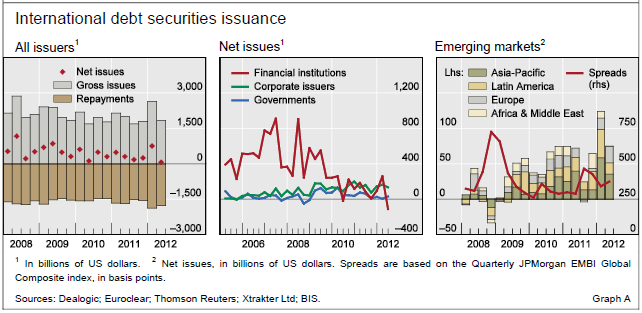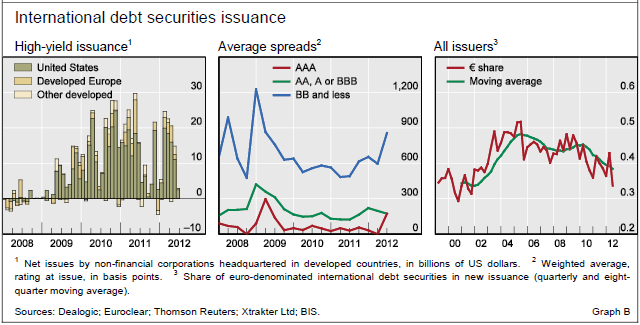International debt securities issuance in the second quarter of 2012
(Extract from pages 18-19 of BIS Quarterly Review, September 2012)
Issuance of international debt securities dropped in the second quarter of 2012. This was attributable mainly to a plunge in issuance by financial institutions, especially those headquartered in the euro area. The decline might reflect a front-loading of issuance to the first quarter as banks sought to exploit the improvement in funding conditions brought about by the ECB's three-year longer-term refinancing operations (LTROs). Moreover, funding conditions in global debt markets deteriorated in the second quarter on revived market tensions in the euro area, weaker than expected economic data in the United States, and worries about the growth outlook in emerging markets, especially China. Meanwhile, investors' appetite for yield in a generally low interest rate environment supported issuance by a few issuer categories, most notably US corporate issuers and, to a lesser extent, emerging market ones.
Global gross issuance of international debt securities amounted to $1,828 billion between April and June, a 30% decrease relative to the previous quarter (Graph A, left-hand panel). With repayments down by only 6%, to $1,765 billion, net issuance dropped by 92% quarter on quarter to $63 billion, the smallest amount since the second quarter of 1995.
Net issuance declined across the globe. Issuers headquartered in Europe made net repayments of $92 billion during the period. Net issuance by US nationals halved to $50 billion and that by emerging market borrowers fell by 40% to $75 billion. International institutions (mostly multilateral development banks) raised $28 billion net.
Financial institutions worldwide reduced their debt in the international market by $137 billion (Graph A, centre panel). This reflected net repayments of $110 billion by institutions in the euro area. Net repayments by US-headquartered institutions were relatively modest, at $38 billion.
Corporate issuers as a whole also reduced net issuance, by 10% quarter on quarter to $144 billion, but there was a contrast between entities headquartered in the United States and others. Notably, European issuers decreased issuance by 35% to $37 billion while US issuers increased it by 17% to $88 billion, taking advantage of low interest rates and investors' appetite for investment grade corporate bonds.
Net issuance by emerging market borrowers dropped significantly from the previous quarter's record (Graph A, right-hand panel), but it remained above the amounts raised in the same quarter of the previous year despite some widening in credit spreads. Borrowers from Asia and the Pacific tapped international debt markets to raise $35 billion. Issuers in emerging Europe increased their funding to $23 billion. Borrowing from issuers headquartered in Latin America amounted to $16 billion. Entities headquartered in China, Russia and Brazil comprised 66% of net issuance and 53% of completed issuance by emerging market borrowers.
Issuance activity in the high-yield bond market segment lost some of the momentum gained in the first quarter, when investors' risk appetite in global debt markets increased after the ECB's first three-year LTRO (Graph B, left-hand panel). Funding conditions for high-yield bond issuers became unfavourable and spreads widened as optimism evaporated and high-yield exchange-traded funds in the United States saw substantial outflows (Graph B, centre panel).
The euro lost some ground as a funding currency in international debt securities markets (Graph B, right-hand panel). Only 34% of total completed issuance was denominated in the currency, the lowest amount since the third quarter of 2001. And net issuance of $181 billion in dollar-denominated debt contrasted with net repayments of $111 billion of debt in euros. As a consequence, the share of euro-denominated international debt securities in the total amount outstanding declined from nearly half in 2008 to 41% in the second quarter.


